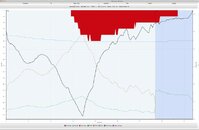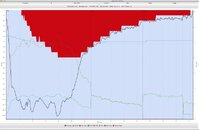The thread was placed in A&I/Near-Misses & Lessons Learned forum. The purpose of the forum is that "
we all may learn from little mistakes that could ultimately be costly".
A purely
academic discussion on CNS% calculation would be better placed somewhere like; 'T2T' (
open and frank discussions among tech diving peers on more advanced topics) or 'Marine Science and Physiology' (
all medical questions related to decompression or diving).
So.. lessons that "
we all may learn from little mistakes that could ultimately be costly":
1) Obtain the correct training and experience to undertake dives of a more complex or hazardous nature.
This would be a leading 'factor' in the 'incident' by any study... and remains a very relevant 'learning point'.
2) Remain within industry/agency-standard guidelines on OTUs, maxPO2
and (
not or) CNS% when planning/conducting dives using nitrox mixtures for bottom or deco purposes.
OP opted to exceed the maxPO2 for his bottom mix and this led him to nearly misdiagnose a simple marine-life irritation; and could be seen as the first rung on an incident chain that nearly led him to omit decompression.
3) Seek a robust understanding of the signs and symptoms of oxygen toxicity (and decompression illness), so that you don't risk misdiagnosing other factors, due to an overly-simplistic or generic interpretation of standard signs/symptom abbreviations.
Whilst I think that point #2 had a direct relevance to the initial misdiagnosis by the near-victim, the need for more complete understanding proves beneficial - especially when a diver may face a situation where they believe they are faced with choosing/selecting a 'lesser of two evils' (risk OxTox or omit deco/bail-out), either of which has the capacity to seriously damage them.
Readers who are not technical qualified and experienced divers should accept that there are significant differences in approach (including mindset) when comparing technical with recreational-level diving. I mean nothing elitist or snobbish in that, it is simply a statement of fact. It is why Scubaboard and other forums typically isolate technical diving threads away from generic/recreational board discussions.
This isn't a recreational nitrox diving incident, whereby immediate access to the surface was an option for the OP. Fudging dive planning/computer algorithms to permit early access to the surface at the expense of ideal decompression isn't a prudent strategy, nor one taught to divers in any formal course, nor recommended by any credible technical diver that I know of.
You can fudge numbers, but you can't fudge what happens in your body when off-gassing. ANY decision to omit/shorten decompression below what was planned and selected as the ideal for that diver, on that dive, is a SERIOUS issue for technical divers. It may seem acceptable from a recreational diving-only perspective - but that merely illustrates the difference in mindset/perspective to which I have alluded.
My concern is only to bring valid learning and safety points from the OP's incident. This may damage the OP's ego, but it is the purpose of this particular forum. Inquiring about training levels
isn't an insult - it is directly relevant to any analysis.
Mindlessly dogmatic repetition of a screed like 'dive this number at this depth or else, because I said so, and anything that ever goes wrong after you violate that rule will be because of that' is best left in church.
If you feel that issues like exceeding community-standard PO2 or omitting planned deco are not useful learning outcomes from your incident, then you have over-intellectualized what was, in reality, quite a serious incident. I class any risk of omitting planned, ideal decompression as a serious incident.
I see a fundamental flaw with happily skipping/reducing decompression 'because of concerns over OxTox', when the same diver has made the deliberate decision to exceed all community and industry accepted limits on PO2 max. Such a flaw, I would predict, stems from insufficient training and education. That's a valid learning point for this forum area.
If/when you seek proper training to conduct these dives, you will learn the difference between 'mindless dogma', common-sense and best practice. Diving safely using nitrox isn't some hard-core 'DIR-dogma'. There is a flaw in spending to much time on the forums seeking hypotheticals and opinions that merely enable you to justify unsafe diving... and not enough time actually learning from credible technical divers who will tell you the blunt truth.
Please don't get yourself hurt; it
can happen to you. The internet is a safe place and it's easy to act confident on a keyboard, but in the water.. OxTox or DCI is not a 'virtual' risk.






